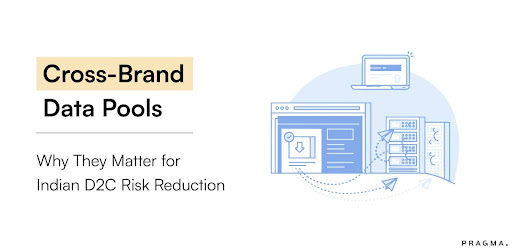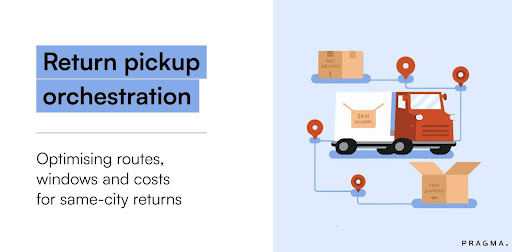RMS - Operational Needs & Integrations
.webp)
Consumers would order multiple products, to test out what suits them best, and return the rest.
There are several reasons behind why a customer might return an item. It may be because of avoidable issues like damage to packaging during transit, defects, or they could have ordered the wrong item.
One can categorize the reason for a return case as controllable or uncontrollable. In any case, the one thing you can control is the Management process of every return.
How to Reduce Return to Origin Shipments
Reduce RTO Orders and Boost Your Margins
Discover proven strategies to minimise Return to Origin shipments, cut unnecessary costs, and deliver a seamless experience for your customers, even during peak seasons.
Start Reducing RTO with Pragma’s RMS Book a Demo
Lower RTO/Return Benefits for Prepaid
- Use banners and reminders: “Prepaid orders ship & refund faster—COD has more delivery issues/RTO.”
- Add microcopy in the cart/checkout: “Returns and refunds for prepaid orders are prioritized. See our easy refund terms.
- Showcase instant RMS-powered refund automation
Thinking about optimizing your Returns Management Process?
A sound returns management process is absolutely worth the investment.
Here’s why — An ideal returns process sees an 18% increase in customer satisfaction and a 5% decrease in cost.
But engineering a returns management process can be a huge task. Which is why many ecommerce brands partner with third-party logistics (3PL) partner(s) to better manage returns - to handle returns for you or even let you manage returns on your own by easily integrating certain applications to effectively streamline your returns process.
( To learn more on one such integration - Checkout Pragma’s RMS )
What do we refer to as Returns Management?
It is simply a System developed to handle product returns efficiently while monitoring various intricate aspects. Some of them include :
- Categorizing requests into returns/refunds/exchanges.
For example: Equal exchange, Full refund. - Warehouse data on specific product necessity (SKUs).
- Closest distribution house for a cost effective delivery.
- Real time monitoring of order status and progress.
- Identifying frauds and manipulations.
And before digging-in deeper, let’s understand the ‘Return Process’
Return Management or “reverse logistics” is basically the opposite of shipping products to a consumer.
The ideal process involves 3 basic steps
Step 1: Initiating a return
- Involves the reason behind a return
- Possible survey to better understand the situation, to identify where the issue began
- Then proceed to categorise the ticket as full refund, replacement, store credit or any other
Step 2: Returned product is received
- The item(s) reach the predetermined distribution/fulfilment centre, warehouse or retail location
- The product(s) is examined and classified as restock, repair, dispose or other category
- Then the information is updated for future reference
Step 3: Return is processed
- The customer is notified on the next step taken. Whether they qualify for a refund/exchange
- Then the request is fulfilled accordingly
The reason behind the emphasis of Streamlining a Returns Management Process is its losses. Where over 42% of customers returned items purchased online in 2020. Resulting in a loss of $328 billion (Worldwide).
And over 50% of those were COD orders.
With over ₹20 crores (India) of revenue lost in the first week of January alone.
There are many reasons why returns reduce profitability. For every returned item, you need to consider:
- Cost of return shipment
- Storage required for said return
- Disposal of defective/damaged item(s)
- Customer complaints/bad reviews
- Potentially losing a loyal customer
How to Minimize return rate
- Your analytics segment should let you know the reason behind a return through repetition. Identify frauds, distinguish between genuine returns and thereby eliminate unnecessary loss of revenue.
- Your layers of Outbound Quality Check (QC) lets you determine the quality of the product standard. And evaluate the chances of getting a return due to ‘Damaged Product’.
- The advantage of Geoanalysis allows you to identify unserviceable areas of a region. Allowing you to omit future orders to the area.
- Layers of verification in your ‘Returns Management’ algorithm lets you minimize incorrect product delivery, incorrect location detail etc.
Returns are unavoidable as long as online sales continue to grow. However, that doesn’t mean you can’t be proactive toward returns. Over time we can guarantee their role towards building an ideal system - where every return can guide you toward optimising internal processes, collect customer feedback, and invariably enhance customer value.
92% of consumers say they will “Return” to you if the returns process was easy and overall positive — hence making it worth the investment.
Let’s begin with some of the ways ecommerce brands can reduce/limit returns induced losses.
How to boost profitability through Returns
- A powerful ecommerce returns management integration, one that allows your business to adapt to the evolving landscape by managing returns seamlessly.
- Automating operations, which translates to less manpower & reduced day-to-day expenditure.
- Optimising your system to identify unreasonable returns through the means of analytical tools.
- Engineer the option to restock, repair, quarantine, resell or dispose of returned product(s) at the SKU level. Allowing you to potentially reduce revenue lost.
- Engineer an apt packaging process suitable for your product, the mode of delivery etc.
(We are referring to the usage of bubble wrap, crinkle paper, plastic bracing, fillers and such to help secure and support packages and to prevent shipping damages.) - Work with high-quality material for a long term benefit.
- Ensure fulfillment rate standards are followed with extra care .
- Partner with carriers in the market with the stamp of approval.
- Provide crystal clear and precise size charts for clothing or other products in order to avoid packaging costs.
- Refine and systemize operations by offering an easy to monitor application such as a single dashboard. Which encompases the brief of all aspects. This enables you to save on unnecessary movement of inventory and other resource-influential aspects.
- Inventory management, with the millennial populace adopting ‘try and return’ habits, your business needs it. To ensure you always have returns that are re-sellable marked as ‘in stock’ and that you also have enough storage capacity. In case you experience a high volume of returns, inventory management integrations will help you manage inventory in real-time.
- Include a crystal clear return policy on your ecommerce site. Provide simple instructions for shoppers to follow, and be honest about expectations, costs, store credits, replacement items, delivery times, and other related information.
Now it’s time to shatter the idea that ‘returns’ lead to lost profit and nothing else. The fact at hand is - not every return leads to a lost sale or customer. But why do we say this? With a smart Returns Management Integration, there are numerous ways to mitigate and/or leverage returns to help facilitate product development and drastically improve customer experience.
The Result? The 92% of the customers we spoke of before...keep coming back.
All thanks to a customer-centric & friendly streamlining of Returns that builds trust with your loyal customers : By being prompt, efficient, and reliable.
How to Improve Customer experience through Returns
- Enable simultaneous handling of orders where you can execute return pick-up, assign replacements/refunds with human intervention.
- Connect warehouse and carrier to customer. Offering the customer the information & various options - replacement with the same or different product, the time in which it can be fulfilled, and more.
- Facilitate quick refunds for both prepaid and COD orders.
- When a customer returns an item, use that opportunity to connect with them and get feedback on why. By doing so, you are taking the time to follow up with unsatisfied customers and you’re given the chance to build trust. You can also offer an incentive or two for them to purchase a product(s) using store credit (e.g., discount coupon).
Fear is the Mindkiller - Frank Herbert
“Delays” are Customer’s Mood Killer - Every Brand
- Automate all of ‘Returns Management’ with an option for Human intervention when it comes to complex order issues.
- Update customers regarding the status of return request in real time
- Educate staff, as they will be handling complex return issues. Work with them to find ways to make your returns process more effective & efficient.
Therefore, to be a “Smooth Operator” when it comes to Returns, you need :
- Quick Order Returns - don’t leave a request open for more than a 12 hours
- Best Order Fulfillment - Deliver replacement within 3 days/refunds within 1
- Attention to detail - Note: this is key in the long run - When the customer refuses the initial judgement of not offering a replacement/return, transfer to a senior customer executive to show personal Attention.
- Ease of Access - An application at hand to easily monitor day-to-day aspects of returns. Ideally through the single dashboard we spoke of before to manage returns across all sales channels/view detailed information and track the return by the returned item’s ID.
To Wrap it Up
There is nor will there ever be any ecommerce business that can prevent 100% of returns, but rendering a returns management process to ease 100% of your work might be. And it begins with integrating and upgrading existing Return Management Processes (RMS) - Instead of viewing them as lost sales, imagine them to be opportunities to improve your product(s) or to create an amazing and memorable brand experience.

FAQs (Frequently Asked Questions On Perfecting Returns Management: Boost Customer Satisfaction & Reduce Costs)
How can returns management improve customer satisfaction and reduce churn?
Fast, transparent, and easy returns build trust and encourage repeat purchases, preventing customers from switching to other brands.
What features should I look for in a returns platform?
Key features include automation, exchange options, rule-based return policies, real-time tracking, integration with couriers, and analytics for fraud or RTO detection.
How can I balance flexible return policies with protection against abuse or fraud?
Segment policies by product and customer, implement multi-level approvals, use automated fraud detection, and limit refundable items where needed.
How does automation streamline the returns process?
Automation speeds up approvals, coordinates shipping, triggers refunds or exchanges, and provides instant customer updates, reducing manual errors.
Can return management solutions help with inventory and cash flow challenges?
Yes. Automated systems quickly reintegrate returned inventory, offer credit over cash refunds, and give brands real-time data for better stock and cash management.
Why is an easy and transparent return policy critical for Indian e-commerce brands?
A clear, prominently displayed return policy builds customer trust, reduces purchase hesitation, and lowers cart abandonment. Indian consumers value return windows of 30-90 days, with flexible options boosting both sales and loyalty.
How can Indian e-commerce brands reduce the cost of returns while keeping customers happy?
Improving product descriptions, adding size guides, enabling self-serve return portals, and offering instant refunds or exchanges cut manual effort and returns processing costs, while enhancing customer experience.
What role does packaging quality play in returns management?
Damaged or mispacked goods cause a significant share of returns in India. Investing in protective packaging tailored to regional delivery challenges prevents damage and reduces costly reversals.
What technologies can Indian e-commerce brands adopt to streamline returns?
AI-powered returns platforms with automated routing, real-time tracking, and personalized exchange nudges modernize returns management, saving up to 40% in operational costs and increasing revenue recovery.
How important is customer communication during the return journey?
Frequent, transparent updates on return status, inspection, and refunds reduce customer anxiety and support tickets, turning potentially negative returns experiences into positive loyalty drivers
Talk to our experts for a customised solution that can maximise your sales funnel
Book a demo




.png)